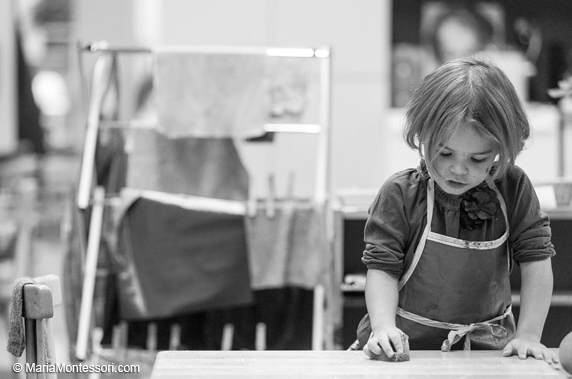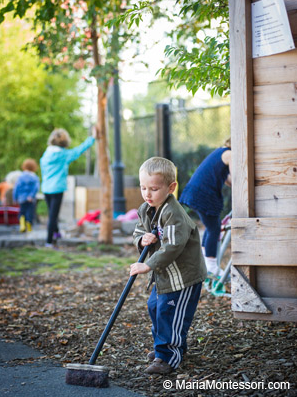
October 24, 2022
For children who are at home during the summer break, parents will wish to work diligently with slowing the pace of life. Children will savor the leisurely passage of time in which they can relish individual choices, uninterrupted play, ample rest and sleep, unhurried meals, and unplugged screens. Here are just a few ideas of how a child can fill her long lovely summer days and return to school refreshed, nourished, and eager:
- Read beautiful, appropriate books (remember, the school has book lists to offer). For the older Children’s House child, begin a chapter book that will develop into a repetitive ritual that she will look forward to and remember with warmth and happiness. Have long leisurely conversations about the characters, the places visited, and the sights and smells. Provide large blank sheets of paper and crayons or watercolors and invite the child to illustrate parts of the story she remembers. Collect these into a handmade book of illustrations.
- Provide long extended periods of outside play with freedom to construct, dig, shovel, and explore to heart’s content. Resist staging and choosing for the child and instead, encourage the blossoming of his own imaginative play efforts.
- Do not be afraid of boredom, for this is the passage to the imaginative, interesting activity of the child’s own choosing.
- Resist the need to provide a playmate or to be a playmate for your child on a regular basis, but instead, honor her ability to find her own entertainment and source of activity. Play-dates are fine for an occasional get-together, but children really do enjoy their own company when given the opportunity to figure it out and enact upon their own ingenuity. The child’s play will reflect what is going on in her world, for this is the source of her imagination.
- Try to develop a schedule with shared responsibilities by the adults so that the children are left with large blocks of uninterrupted play (which is their summer ‘work’). Shopping is really an adult activity and few children derive any enrichment from the ordeal of being taken from store to store.
- Border a portion of the garden/yard for the child to tend with appropriate size tools and gear. Give just enough guidance and instruction so that she will know how to use the tools and how to tend her section. Be friendly with error as she learns this craft. Also, a small portion of the yard can be cordoned for digging exploration and the collecting of objects found. Provide a tray and space to store these treasures. The goal is that these activities will be something the child wishes to return to often and engage in at will. Small creatures/insects that are encountered are respected by observing them in their natural habitat. Books are read as encounters are made. Let it be an organic development.
- Include practical life experiences in your child’s day that will provide ritual, a marking of the passage of time, and a sense of responsibility in family life:
- Sweeping designated areas inside and/or out
- Washing windows with a spray bottle of vinegar water, and wipe them clean with newspaper
- Sorting and loading laundry into the washing machine
- Folding laundry together
- Setting the table, clearing the table after a meal
- Helping peel vegetables for dinner
- Ironing (older children) the napkins and small cloth (under the watchful eye of an adult, using a mildly warm small iron)
- Making the bed together
- Culling through toys and deciding what to discard and what to keep
- Washing shoes, especially the outdoor play shoes that will probably need refreshing
A few short day trips in which the children can participate in the planning and executing of the events can result in happy moments for summertime:
- A visit to the Austin Children’s Museum
- A visit to McKinney Falls State Park, with a basket lunch, prepared
- A visit to the Ladybird Johnson Wildflower Center (skip the shop and focus on the natural environment)
- An hour of play and lunch on the grounds of a local park/playground, particularly if within walking/biking distance

Occasionally a parent will ask for guidance about working with their child on academic work during the summer break, mostly out of concern for the child’s ability to sustain previous learning. We encourage the parent to recognize that the child needs the balance offered by a summer of relaxation and reflection. It is in the reflection that true, deep-seated learning takes place. Just as in the classroom the guide can observe children engaged in reflection following an engrossing, focused work (be it washing a table with vigor and precision or exploring the operations of addition with the stamp game), and she will respect this moment, children will use their summer downtime to reflect on what they have already achieved in the school year. This will be observed in their desire to do a practical life activity spontaneously (one mother related to me that her child, immediately after breakfast, collected his bucket and sponge and cleaned the refrigerator and repeated this exercise several times during the summer), or a desire to write a letter or a word or a story, depending upon his development, or work some simple math combinations. I tell parents that it is fine to follow the child’s lead in these activities, to answer the child’s questions (‘how is number five written?” or ‘how is the word kitten written”- hint: we sound it out ‘k i t i n’). Having papers of various colors and sizes, along with crayons (and pencils for those children who have been introduced to the metal inset work), available in a container and accessible to children for spontaneous work and creation will go a long way in providing them an opportunity to put into a concrete form their reflections of previous learning. Spontaneous reflection of this nature will allow the child space to engage his mind academically without the pressures of additional formal lessons. I also like to remind parents that when we write in front of the children, we use beautiful, well-formed cursive letters.
Sharing the summertime break with extended family and friends offers not only time to catch up on each other’s lives and experiences but also often provides challenges on how to continue on the path one has thought through with intention and care that the child is not exposed to media content or entertainment inappropriate to her development. We accept others’ choices of both lifestyle and family values but remain dedicated to our child’s developmental stage and needs of rest, appropriate nourishment, and contact with the outdoor world.
Whenever the families we love and long to spend time with have differing lifestyles, we must be the ones to consider alternatives that are thoughtfully offered. Perhaps we can research and offer a vacation spot that is equal-distant from each group and plan to rendezvous because there is a wealth of outdoor environment of woods for walking, water for swimming, lawn for play, places to set up lunch in the open air and enjoy long, lazy get-togethers while over- seeing the combined brood of children – and the media has been left behind.
If the extended family is local and just a drive away, perhaps we can take the initiative to organize several play days for whole groups outdoors in one of the local parks. This could be a well-thought-out plan of energetic games balanced by restful periods of portable meals and quiet lying about on blankets, under umbrellas that shade the sun. Book readings and quiet conversation (always being conscious of the children who will be absorbing every word we utter) after an energetic walk or game are the stuff of memories, especially if ‘ritualized’ over a one or two-week period with the people most loved in one’s life. It is true that great thought and energy will have to go into books to take (appropriate real stories about real life), food to pack (share nourishing, tempting recipes with other family members and share the menu), and games appropriate to the children’s development, but this will form the basis of the time spent together. I vividly remember childhood family gatherings in the summer in the piney woods of a Louisiana park. There were all generations of family members, many stories to hear, running and hiding games under the watchful supervision of the adults, luscious Louisiana watermelon, and homemade sandwiches to eat. Do extended families get together like this anymore – away from the indoors and into the ‘wilds’ of the outdoors?
As the ones who have the vision for their child’s development, we must plan for opportunities to gather with the ones we love AND accept the leadership in planning, recruiting support, and providing for pleasurable re-connections with family and friends that do not exhaust our children or unravel our best-laid plans for their development.
Locating and matching the perfect summer rendezvous for your child might take time and planning but your child is worth all of the effort. For us, the adults, the summer is fleeting, but for children, it is a world unto itself that stretches out forever, until, magically, someone says it is time for school again. Your child’s guide will be ready to receive a well-rested, well-nourished child who has developed her sense of self a bit more through the leisurely passage of summer activity.